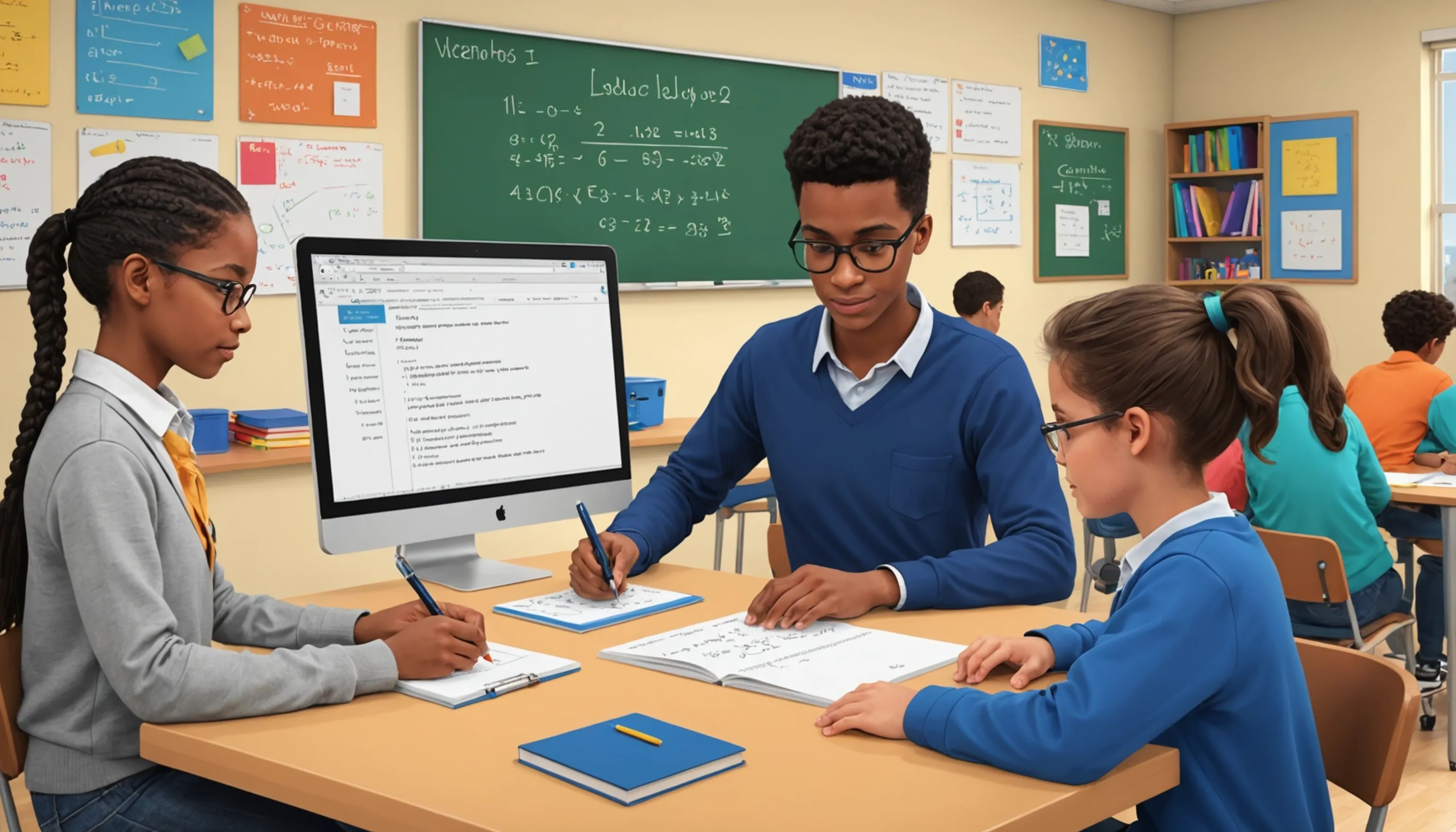Algebra Explained for Parents and Teachers
 HvWHenry van Wagenberg
HvWHenry van Wagenberg
Understanding Algebra: A Guide for Parents and Teachers
Understanding algebra is crucial for parents and teachers who wish to support their teenagers effectively. Algebra serves as a foundation for advanced mathematics and many real-world applications. It involves working with variables and expressions to solve problems, making it essential for developing critical thinking and problem-solving skills.
As educators and guardians, it's important to create an environment that fosters curiosity and encourages students to engage with algebraic concepts. Providing resources, guidance, and a positive attitude towards math can significantly enhance a teen's learning experience and confidence in their abilities.
What is Algebra?
Algebra is a branch of mathematics that deals with symbols and the rules for manipulating those symbols. It is a unifying thread of almost all mathematics and a foundational skill for students to master as they progress in their education. At its core, algebra involves the use of variables—symbols that represent numbers in equations and expressions.
In algebra, students learn to formulate and solve equations that model real-world situations. This includes understanding concepts such as:
- Variables and Constants: Variables are symbols like x or y, while constants are fixed values.
- Expressions: An expression is a combination of variables and constants, such as 2x + 3.
- Equations: An equation states that two expressions are equal, like 2x + 3 = 7.
- Inequalities: These express a relationship of greater than or less than, such as x > 5.
Algebra also introduces students to functions, which describe relationships between quantities. Understanding algebra is essential not just for higher-level math but also for fields such as science, engineering, and economics. By grasping these fundamental concepts, students build critical thinking skills that are applicable in everyday problem-solving.
Importance of Algebra in Education
The importance of algebra in education cannot be overstated, as it serves as a foundation for many advanced concepts in mathematics and various fields. Algebra equips students with essential skills that are crucial for academic success and everyday problem-solving. Here are some key reasons why algebra is vital in education:
- Critical Thinking: Algebra teaches students to think logically and analytically. They learn to break down complex problems into manageable parts, enhancing their overall reasoning abilities.
- Real-World Applications: Algebra is not just theoretical; it is used in real-life situations such as budgeting, cooking, and even in professions like engineering and architecture. Understanding algebra allows students to apply mathematical reasoning to everyday challenges.
- Preparation for Advanced Studies: Mastery of algebra is a prerequisite for higher-level math courses such as geometry, trigonometry, and calculus. A solid grasp of algebraic concepts prepares students for success in these advanced classes.
- Career Opportunities: Many careers require a solid foundation in mathematics, including fields like science, technology, engineering, and mathematics (STEM). Proficiency in algebra can open doors to various career paths and enhance job prospects.
By emphasizing the importance of algebra in education, parents and teachers can inspire students to engage with the subject and appreciate its relevance in both academic and real-world contexts.

Common Algebra Concepts Teens Should Know
Teens should be familiar with several key algebra concepts to build a solid foundation in mathematics. These include:
- Variables: Symbols that represent unknown values, typically denoted by letters like x or y.
- Expressions: Combinations of variables and constants, such as 3x + 4.
- Equations: Statements that two expressions are equal, like 2x = 10.
- Inequalities: Expressions that show a relationship of greater than or less than, such as x > 5.
- Functions: Relationships that express how one quantity depends on another.
Mastering these concepts is crucial for success in higher-level math.
Variables and Expressions
In algebra, variables and expressions are fundamental concepts that serve as building blocks for understanding more complex topics. A variable is a symbol, usually a letter like x or y, that represents an unknown value in mathematical expressions and equations. For example, in the expression 2x + 3, x is the variable, and its value can change depending on the context.
Expressions are combinations of variables, constants, and mathematical operations such as addition, subtraction, multiplication, and division. They do not have an equality sign, which distinguishes them from equations. For instance, 4y - 5 is an expression where y is the variable, while 4y - 5 = 7 would be an equation.
Understanding how to manipulate variables and expressions is crucial for solving algebraic problems. Here are some essential skills related to variables and expressions that teens should learn:
- Combining Like Terms: This involves simplifying expressions by adding or subtracting terms that have the same variable component. For example, 3x + 4x simplifies to 7x.
- Evaluating Expressions: Teens should practice substituting values for variables to calculate the outcome of expressions. For example, if x = 2, then 3x + 1 becomes 7.
- Understanding Order of Operations: It's vital to know the correct order to perform operations in expressions, usually remembered by the acronym PEMDAS (Parentheses, Exponents, Multiplication and Division, Addition and Subtraction).
Mastering variables and expressions lays the groundwork for solving equations and inequalities, making them essential concepts in algebra.
Equations and Inequalities
Equations and inequalities are core components of algebra that teens need to understand for effective problem-solving. An equation is a mathematical statement that asserts the equality of two expressions, typically involving variables. For example, the equation 3x + 5 = 20 indicates that the expression on the left is equal to the expression on the right. To solve an equation, students must isolate the variable by performing inverse operations. In this case, subtracting 5 from both sides and then dividing by 3 yields the solution x = 5.
On the other hand, an inequality expresses a relationship where one side is greater than or less than the other, using symbols like >, <, ≥, or ≤. For instance, the inequality x + 3 < 10 shows that x must be less than 7. Solving inequalities follows similar principles as solving equations, but it’s essential to remember that multiplying or dividing both sides by a negative number reverses the inequality sign.
Understanding how to work with equations and inequalities enables teens to tackle a variety of mathematical problems. Here are some important concepts related to equations and inequalities:
- Graphing: Students should learn how to graph equations on a coordinate plane and represent inequalities with shading.
- Systems of Equations: This involves solving multiple equations simultaneously, which can be done using substitution or elimination methods.
- Real-World Applications: Equations and inequalities can model real-life scenarios, such as budgeting or calculating distances.
Mastering these concepts will greatly enhance students' mathematical skills and prepare them for advanced topics in math.

Functions and Graphs
Functions and graphs are critical concepts in algebra that help students understand relationships between variables. A function is a specific type of relation where each input (usually represented by x) has exactly one output (often represented by y). For example, the function f(x) = 2x + 3 defines a relationship where the output is determined by doubling the input and adding three.
Understanding functions allows teens to analyze how changes in one variable affect another. Functions can be represented in various forms, including:
- Algebraic Form: Such as f(x) = x^2 - 4, which defines a quadratic function.
- Table of Values: A table can illustrate how different input values correspond to output values.
- Graphical Representation: Graphs visually display the relationship between variables, helping to identify trends and patterns.
When graphing functions, students plot points based on pairs of input and output values on a coordinate plane. The shape of the graph can provide insights into the behavior of the function. For instance:
- A linear function yields a straight line.
- A quadratic function produces a parabolic curve.
Understanding the concept of a function also sets the stage for exploring transformations, such as shifting, stretching, or reflecting graphs. Learning about functions and graphs not only enriches students' mathematical knowledge but also enhances their problem-solving skills, making these concepts essential in both academic settings and real-world applications.
Supporting Your Teen in Learning Algebra
Supporting your teen in learning algebra is crucial for their academic success and confidence in mathematics. Here are some effective strategies to help them navigate this subject:
- Encourage a Growth Mindset: Remind your teen that learning algebra is a process. Mistakes are part of learning, and persistence is key.
- Provide Resources: Offer access to textbooks, online tutorials, and educational apps that explain algebraic concepts in engaging ways.
- Create a Study Routine: Establish a regular time for studying algebra to create consistency. This will help your teen stay organized and focused.
- Practice Together: Work on algebra problems together to reinforce concepts. This also provides an opportunity for you to clarify any misunderstandings.
- Communicate with Teachers: Stay in touch with your teen's math teacher to monitor progress and identify areas needing additional support.
Your involvement can make a significant difference in your teen's attitude and performance in algebra.
Resources for Parents and Teachers
There are numerous resources available for parents and teachers looking to support teens in learning algebra. These resources can help clarify concepts, provide practice opportunities, and enhance understanding. Here are some valuable options:
- Online Learning Platforms: Websites like Khan Academy and IXL offer interactive lessons, practice problems, and instructional videos covering a wide range of algebra topics. These platforms allow students to learn at their own pace and revisit challenging concepts.
- Math Apps: Mobile applications such as Photomath and Algebrator can assist students in solving algebra problems. These apps provide step-by-step solutions, helping students understand the problem-solving process.
- Workbooks and Textbooks: Many workbooks are designed specifically for algebra practice. They often include exercises that align with common core standards and provide solutions for self-assessment.
- YouTube Channels: Educational YouTube channels like Math Antics and PatrickJMT offer engaging videos that break down complex algebra concepts into easily digestible segments.
- Local Tutoring Centers: If additional help is needed, consider enrolling your teen in a local tutoring center. Personalized instruction can make a significant difference in understanding algebra.
By utilizing these resources, parents and teachers can create a supportive learning environment that encourages teens to excel in algebra and build confidence in their math skills.
Tips for Helping Teens with Algebra Homework
Helping teens with their algebra homework can be a rewarding experience that fosters learning and builds confidence. Here are some effective tips for parents and teachers to support students in tackling algebra assignments:
- Create a Conducive Environment: Ensure that your teen has a quiet, organized space dedicated to studying. This can help minimize distractions and improve focus during homework sessions.
- Encourage Understanding Over Memorization: Emphasize the importance of grasping the underlying concepts instead of just memorizing formulas. Encourage your teen to ask questions and explore the reasoning behind algebraic principles.
- Break Down Problems: Teach your teen to break complex problems into smaller, manageable parts. This approach can make it easier to understand and solve challenging equations or expressions.
- Utilize Resources: Encourage the use of online resources, such as instructional videos or math apps, to reinforce concepts and provide additional practice. Tools like Khan Academy or Mathway can be incredibly helpful.
- Promote a Positive Mindset: Help your teen develop a positive attitude towards math by celebrating their efforts and progress. Remind them that making mistakes is a natural part of learning.
- Be Patient and Available: Offer support without doing the work for them. Be available to guide them through challenging problems while encouraging independent thinking.
By implementing these tips, parents and teachers can create a supportive learning atmosphere that empowers teens to succeed in algebra.
Encouraging a Positive Attitude Towards Math
Encouraging a positive attitude towards math, especially algebra, is essential for fostering a love for learning and boosting confidence in teens. A positive mindset can significantly affect their performance and willingness to engage with challenging concepts. Here are several strategies to help cultivate a positive attitude towards math:
- Model a Positive Mindset: As a parent or teacher, demonstrate enthusiasm for math. Share your own experiences, including challenges and successes, to show that learning is a journey filled with ups and downs.
- Use Real-Life Applications: Help teens see the relevance of algebra in everyday life. Discuss how math is used in budgeting, cooking, and even in planning events. Relating math to real-world scenarios can make it more engaging and less intimidating.
- Celebrate Small Wins: Recognize and celebrate progress, no matter how small. Acknowledging achievements can boost self-esteem and motivate students to continue working hard.
- Encourage Collaboration: Promote group study sessions where teens can work together to solve algebra problems. This collaborative approach can make learning more enjoyable and less isolating.
- Provide Constructive Feedback: When reviewing homework, focus on what your teen did well before addressing areas for improvement. This approach helps maintain motivation and encourages a growth mindset.
- Offer Encouragement: Regularly remind teens that effort and persistence are more important than innate ability. Encourage them to embrace challenges and view mistakes as opportunities for growth.
By implementing these strategies, parents and teachers can help create a supportive atmosphere that encourages teens to develop a lifelong appreciation for math.
